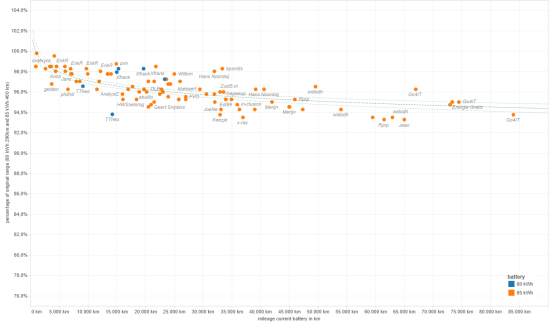Tesla Motors gives an 8 year infinite miles battery guarantee. However, it is still relevant for every Tesla driver to know what to expect of the degradation of the capacity over time, because it is equivalent to the range of your car. In the Netherlands, Merijn Coumans is updating on a regular basis, via the Dutch-Belgium Tesla Forum, a file of owners’ data. The most recent version of the results is displayed below.


In the figure the percentage of range loss is shown on the vertical axis, so that 85 kWh (orange) and 60 kWh (blue) types can be compared. The horizontal axis displays the distance driven with the vehicles.
The way to measure is to do a range (full) charge (100%) and then check the typical (in the US this is called rated) or rated (in the US this is called ideal – EPA) range. In the plot, these numbers are compared to the 0 km range data – for a 85kWh Model S this is about 400 km typical or 500 km rated (EPA). Although there is uncertainty because of the range estimation, as well as because of the state of the battery (balanced or not), the rated (US: ideal) measure is seen as the most reliable, especially if before the range charge the battery was almost empty.
From the figure it is clear that the degradation slows down with more driven km. After say 80.000 km (50.000 miles), the overall range degradation is seen to be approximately 6%, with a rate of appr 1%/50.000 km (1%/30.000 miles) from that point onwards.
The data collected by Merijn, also include how many Supercharger visits were done, among other details. See the forum for more information, or if you want to upload your data. An interactive version of the picture and data can be found here.